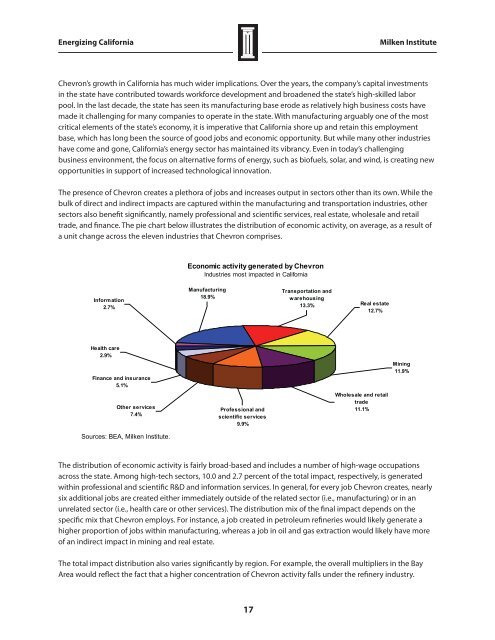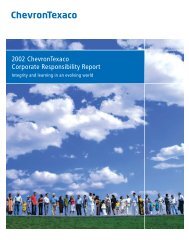Energizing California - Chevron
Energizing California - Chevron
Energizing California - Chevron
You also want an ePaper? Increase the reach of your titles
YUMPU automatically turns print PDFs into web optimized ePapers that Google loves.
<strong>Energizing</strong> <strong>California</strong><br />
Milken Institute<br />
<strong>Chevron</strong>’s growth in <strong>California</strong> has much wider implications. Over the years, the company’s capital investments<br />
in the state have contributed towards workforce development and broadened the state’s high-skilled labor<br />
pool. In the last decade, the state has seen its manufacturing base erode as relatively high business costs have<br />
made it challenging for many companies to operate in the state. With manufacturing arguably one of the most<br />
critical elements of the state’s economy, it is imperative that <strong>California</strong> shore up and retain this employment<br />
base, which has long been the source of good jobs and economic opportunity. But while many other industries<br />
have come and gone, <strong>California</strong>’s energy sector has maintained its vibrancy. Even in today’s challenging<br />
business environment, the focus on alternative forms of energy, such as biofuels, solar, and wind, is creating new<br />
opportunities in support of increased technological innovation.<br />
The presence of <strong>Chevron</strong> creates a plethora of jobs and increases output in sectors other than its own. While the<br />
bulk of direct and indirect impacts are captured within the manufacturing and transportation industries, other<br />
sectors also benefit significantly, namely professional and scientific services, real estate, wholesale and retail<br />
trade, and finance. The pie chart below illustrates the distribution of economic activity, on average, as a result of<br />
a unit change across the eleven industries that <strong>Chevron</strong> comprises.<br />
Economic activity generated by <strong>Chevron</strong><br />
Industries most impacted in <strong>California</strong><br />
Information<br />
2.7%<br />
Manufacturing<br />
18.9%<br />
Transportation and<br />
w arehousing<br />
13.3% Real estate<br />
12.7%<br />
Health care<br />
2.9%<br />
Finance and insurance<br />
5.1%<br />
Other services<br />
7.4%<br />
Sources: BEA, Milken Institute.<br />
Professional and<br />
scientific services<br />
9.9%<br />
Wholesale and retail<br />
trade<br />
11.1%<br />
Mining<br />
11.9%<br />
The distribution of economic activity is fairly broad-based and includes a number of high-wage occupations<br />
across the state. Among high-tech sectors, 10.0 and 2.7 percent of the total impact, respectively, is generated<br />
within professional and scientific R&D and information services. In general, for every job <strong>Chevron</strong> creates, nearly<br />
six additional jobs are created either immediately outside of the related sector (i.e., manufacturing) or in an<br />
unrelated sector (i.e., health care or other services). The distribution mix of the final impact depends on the<br />
specific mix that <strong>Chevron</strong> employs. For instance, a job created in petroleum refineries would likely generate a<br />
higher proportion of jobs within manufacturing, whereas a job in oil and gas extraction would likely have more<br />
of an indirect impact in mining and real estate.<br />
The total impact distribution also varies significantly by region. For example, the overall multipliers in the Bay<br />
Area would reflect the fact that a higher concentration of <strong>Chevron</strong> activity falls under the refinery industry.<br />
17

















